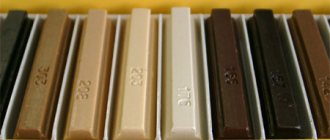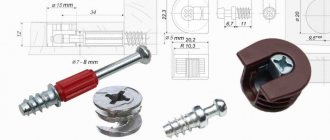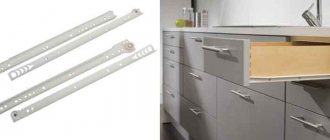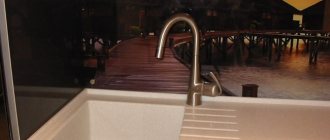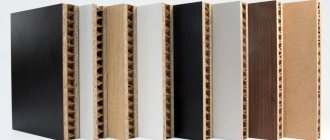To assemble furniture, you need not only the skills and experience of a craftsman, but also high-quality fasteners. One of the most popular methods of fixing parts is the technology using a Euroscrew. The element allows you to securely attach to the material in one operation.
You just need to make a geometrically correct hole. To do this, you need a special drill for confirmat (euroscrew). Its dimensions are strictly defined. The product is unified to a single standard, so it can be easily replaced with a similar one from another manufacturer.
Types of confirmations and holes for them
Externally, the Euroscrew resembles a screw, from which it fundamentally differs in the diameter and shape of the cut tooth. This design feature allows you to increase the area of contact with the body of the fastened part several times. As a result, connection reliability increases significantly.
One confirmat replaces 3-4 screws of the same length. For furniture made from chipboard, the figures are even more impressive. The middle of the sheet is the loosest part of the material. A thin screw is not able to securely fix itself. Due to its larger diameter, the Euroscrew captures harder layers of chipboard and it is no coincidence that manufacturers clearly prefer it.
Manufacturers offer a line of products with different sizes for different types of connections. Not all models can be found in the store. Some are used only for special purposes. They can be ordered or purchased at specialized retail outlets.
| Model | 5x40 | 5x50 | 7x40 | 7x50 | 7x60 | 7x70 |
| Overall length, mm | 38,5-40,0 | 48,5-50,0 | 35,5-40,0 | 48,5-50,0 | 58,5-60,0 | 68,5-70,0 |
| Cap diameter, mm | 7- 7,5 | 7- 7,5 | 9,5-10 | 9,5-10 | 9,5-10 | 9,5-10 |
| Head length, mm | 6 | 6 | 10 | 10 | 10 | 10 |
| External thread diameter, mm | 4,7-5 | 4,7-5 | 6,3-7 | 6,3-7 | 6,3-7 | 6,3-7 |
| Diameter at the bottom point of the thread, mm | 3,4 | 3,4 | 4,7 | 4,7 | 4,7 | 4,7 |
The method of twisting the confirmat depends on the shape of the head. It can be hexagonal or cross-shaped. For euroscrews of small diameter (5 mm) a 3 mm wrench is used, and for large products (7 mm) a 4 mm wrench is used.
The drill dimensions are determined in accordance with the table. Depending on the material, the hole for the thread is made either 3.5 mm or 4.5-5 mm. The confirmatory head requires a diameter of 5 mm and 7 mm, respectively, depending on the brand.
How to choose the right one
To make a choice, you need to measure the Euroscrew head (its inner part). Performance may vary from manufacturer to manufacturer.
The end of the Euroscrew is blunt, which is a distinctive feature of this element.
If the resulting value is 6.3 - 7 mm, a 7 mm drill will do. It is universal for mount models 7x40 - 7x70 mm.
Euroscrews come in different shapes.
Even if a slight backlash is formed during drilling, it’s okay. As a last resort, you can loosen the connection, adjust the location of the parts and re-tighten the confirmation.
The method of twisting the confirmat depends on the shape of the head.
The same applies to models 5-40 and 5x50. 5-6 mm drills are suitable for them.
Design features of drills for confirmations
Euroscrews are used both on hardwood products and on furniture made from chipboard and LMDF. In these cases, the load on the tool is high. When choosing low-quality products, noticeable wear of the cutting edge occurs. When purchasing, you need to make sure that the confirmat drill has a Rockwell hardness of 61-64. A self-respecting manufacturer indicates this value on the packaging.
If the drill falls into the hands of a master without information about the product, then you need to look at the body of the product. Domestic manufacturers write the steel grade. Drills made from alloys R9M5 and R18 are considered the best. Among imported products, products made from HSS 4341 have excellent performance. The abbreviation stands for High-Speed Steels, that is, just like P9M5 and P18, it is high-speed steel.
It is most convenient to use a finished product, where the diameter of the drill is precisely selected for the confirmation and there is an additional cutting edge for the head, where there is no thread, and to create a chamfer for the head. The design increases productivity several times.
Three operations are performed in one pass. You can use a set of drills of the required diameter. However, for better performance it needs to be improved. The factory device has a sharper sharpening angle of the cutting edges. This makes the approach easier and more accurate.
What is a furniture drill for confirmation?
The most suitable for installing confirmations are drills that are equipped with a working head. One side of the device makes a hole along the diameter of the neck, and the other countersinks the place where the cap will be located.
Fastening elements can be nails, screws and self-tapping screws.
Types and benefits
For work, ordinary furniture drills and those equipped with a step cutter are used. In the first case, small chips may remain on the surface, which will be covered by the screw head.
The production of durable cabinet furniture largely depends on the use of high-quality materials and fittings.
Drills equipped with a step cutter are more suitable. With their help, you can immediately chamfer the location of the screw head.
If the drill falls into the hands of a master without information about the product, then you need to look at the body of the product.
Using such a tool allows you to get a hole of the desired diameter in one go.
To assemble furniture, you need not only the skills and experience of a craftsman, but also high-quality fasteners.
For your information. A step cutter forms a suitable surface for the confirmat head. It doesn't leave any chips.
Use any electrical appliances carefully.
When purchasing, you need to check the hardness of the drill. It should be 61-64 Rockwell. This value can be found on the product packaging.
Euroscrews are used both on hardwood products and on furniture made from chipboard and LMDF.
If it is impossible to view the information (the factory packaging is lost), then you can look at the data indicated on the drill body.
On Russian products the steel grade is indicated. Products made from R18 and R9M5 alloys have the best performance characteristics. On European drills you need to look for the HSS 4341 marking, which indicates that the product is made of high-speed steel.
One confirmat replaces 3-4 screws of the same length.
Drill dimensions
The dimensions of furniture drills are determined depending on the material and dimensions of the confirmat. At home, craftsmen are recommended to use drills of a smaller diameter.
Drills have different lengths.
Correspondence of models and thread sizes:
- 5x40 and 5x50 - thread for the lower hole - 3.4 mm, outer - 4.7-5 mm;
- 7x40, 7x50, 7x60 and 7x70 - thread for the lower hole is 4.7, external - 6.3-7 mm.
Euroscrews are suitable for working with furniture.
How to choose a drill?
Before you start assembling furniture, you need to prepare all the tools. Information about the Euroscrew itself will help you choose which drill to use for the confirmation. If you have a ready-made device of the right brand, then there will be no problems.
However, often in the practice of home craftsmen there is a situation when they have to work with what is available. It is strongly not recommended to use drills of a smaller diameter - for confirmations 5x40, 5x50 this size is 3.4 mm, and for products 7x40, 7x50, 7x60, 7x70 - 4.5 mm.
The fastening element does not screw into a hole that is not large enough in size and becomes jammed. If you work with furniture parts made of chipboard or LMDF, then at best they will swell, and at worst they will crack.
The head of the confirmat is measured, the part that is inside the product but does not have a thread. It may vary slightly between different manufacturers. The diameter ranges from 6.3mm to 7mm. Which confirm drill should I choose in these cases? The factory device is designed for a diameter of 7 mm.
How to connect?
To connect two parts made of laminated chipboard (the thickness of one sheet is 16 mm), a euroscrew is used. One of the most affordable and accessible methods today. To install it you will need:
- drill;
- drills 4.5 mm and 7 mm or “confirmed” drill;
- handle, square, hex key.
The advantages of a confirmat over an ordinary self-tapping screw are great, because it not only pulls the parts together, but also firmly holds them from lateral displacement.
Read also: How to restore nickel-cadmium batteries for screwdrivers
Otherwise, the confirmation will fall out, or, on the contrary, it will tear the chipboard, and you will ruin the furniture.
It is necessary to tighten two parts with a thickness of 16 mm. We retreat 8 mm along the vertical part of the part and draw a center line and put a dot. We make a hole using a drill with a diameter of 7 mm. On the second part we do the same, only we take a drill with a diameter of 4.5 mm. If you have a “confirmed” drill, the work is reduced significantly, but such a drill is quite difficult to find. All you need to do is make a hole and connect the two pieces together. The use of such a drill is rational in case of a large volume of work and repeated use. It is not advisable to buy such a drill for “one-time” use.
Confirmat will hold securely and firmly even if there are pores in the chipboard.
The main thing here is to maintain all sizes.
When assembling furniture, confirmat 6.4*50 is used. To connect the parts efficiently, the hole diameter should be 4.5-5 mm. and 50mm deep.
Using Euroscrews, you get high reliability of the sections tightened with this fastener.
To connect the parts efficiently, the hole diameter should be 4.5-5 mm. and 50mm deep.
Device Manufacturers
The correct name for a fastener is a single-piece fastener. This term is used to fill in data when ordering and to draw up reporting documentation at specialized enterprises. In everyday life, it is more common to hear other names, for example, “euroscrew”, “euroscrew”.
The word confirmat appeared thanks to the trade name of the Hafele company from Germany Confirmat. This category of fasteners appeared back in the 70s of the last century, but they gained real popularity in the 90s. Since then, products have been produced by many domestic and foreign manufacturers, including the Hafele company, which is successfully operating to this day.
The demand for products in large quantities is covered by Russian enterprises. These are ZAO Izhevsk Furniture Accessories Plant FMS, JSC Metallist and many others. Products from Chinese manufacturers are widely represented on the market, the quality of which is not always at the proper level. But one of the oldest enterprises in China, Haining Yicheng Hardware Co., Ltd. you can trust.
The best manufacturers
The unsurpassed leader in production remains Hafele, the brand that was the first to supply these fasteners to the market. The company's products are made of high-quality steel and are excellent for installing hardware.
Products from the German company Hammer Werkzeug GmbH are also trusted. Among Russian manufacturers, one can note the Praktika company.
Drilling rules
Reliable and accurate fastening of furniture parts depends on following the step-by-step instructions. The drilling procedure and rules are as follows:
- Check whether the confirmat drill matches the available Euroscrews.
- Make precise markings on the parts, taking into account allowances.
- Fix one or both workpieces in the desired position.
- Drill a hole, controlling the position of the tool.
A drilling device will be a good helper in your work. Similar universal products are available for sale, but you can make them yourself. Designs vary, from simple templates to devices with guide bushings for precise drill orientation.
It is very convenient to use universal devices for adding furniture parts. They are used to make preliminary holes of smaller diameter.
They have a certain thickness and a standard confirmat drill, the dimensions of which are not designed for this operation, will not work. They are given finishing treatment. All the same, the end result is a gain in time, and most importantly in the accuracy of the holes.
Modern furniture made of chipboard and MDF is often assembled using confirmatory screws, which among furniture makers are also called Euroscrews or Euroscrews. Before screwing them in, technological holes with strictly specified parameters are drilled in the plates. The process of preparing these holes will be discussed in this article.
The hole for the confirmation is drilled in the thickness of the first part and in the end of the second part, which are joined at a right angle. Along the length it should have a stepped difference in diameters. This is due to the design features of the Euroscrew. Its rod consists of a cylindrical smooth neck and a main threaded part. A hole of a smaller diameter is drilled for the thread, and a larger one for the neck. The fastener also has a countersunk head in the shape of a truncated cone, for which a seat is prepared. In practice, two hole drilling technologies are used.
Recommendations and tips for use
Before using the drill, mark the location where you want to use it.
To obtain a reliable connection of parts, you need to follow a number of rules:
- select a drill that meets European certificates;
- apply precise markings on the component parts (take allowances into account);
- fix the details;
- control the tool while drilling.
Use quality tools for the job.
For greater convenience, you can get a special tool. You can purchase a ready-made one or make it yourself: cut out a wooden template with a metal sleeve for the drill inside.
Buy quality drill bits.
Universal devices for adding parts will help you complete the job faster and achieve maximum assembly quality. With their help, preliminary holes of smaller diameter are made.
You can find instructions for using the drill on the Internet.
Using three drills of different diameters
This method is suitable for small volumes of work, as it requires more time. Hole preparation is performed in three approaches:
First step
– drilling through two parts for the entire length of the Euroscrew. The diameter of the drill must be equal to the diameter of the screw body without taking into account the thread. This is done so that the threads can cut a counter thread in the material.
Second step
– expansion of the already obtained hole for the smooth part of the hardware, which should have a tight fit, but not too tight, so as not to split the material. Reaming is performed with a drill equal to the thickness of the neck and to a depth equal to its length.
Third step
– countersinking a hole to deepen the head into the material. This can be done with a drill of a larger diameter, but to obtain a high-quality result without chipping, it is better to perform this operation with a countersink.
Confirmation drill – three in one
Working with a special confirmat drill (cutter) is much easier, since it has a special stepped geometry, and the entire operation is performed in one pass. An additional advantage of using it is that it simultaneously chamfers the countersunk head of the hardware. In fact, it replaces two drills and a countersink of different diameters. In addition, the confirmatory cutter has an insertion part with a sharp tip, which ensures precise insertion of the tool and eliminates the risk of it being pulled to the side at the beginning of drilling.
Dimensions of holes for confirmation
There are no GOST standards for confirmed screws; they are manufactured according to European standards 3E120 and 3E122 and have a fairly wide size range, represented by the following standard sizes: 5x40, 5x50, 6.2x50, 6.4x50, 7x40, 7x48, 7x50, 7x60, 7x70 mm.
The most common size is 6.4x50 mm
. To drill a hole for its thread, a drill with a diameter of 4.5 mm is used, and for the smooth part - 7.0 mm.
When working with euroscrews of other sizes, the following rule is adhered to: the diameter of the main hole (for the thread) must be equal to the diameter of the rod without taking into account the height of the thread. That is:
- 5 mm screw – 3.5 mm drill
- 7 mm screw – 5.0 mm drill
In order to prevent the risk of parts moving during drilling, it is necessary to firmly fix their position relative to each other. The easiest way to do this is with a corner clamp or other clamps.
Confirmat is the most popular fastening element used in the production of cabinet furniture. Confirmations became widespread back in the 90s of the last century and since then have been actively used by specialists working in furniture production.
Confirmats are great for assembling homemade furniture
The correct name for this fastening element (along with the designations “Euroscrew”, “Euroscrew”, and sometimes simply “Euroscrew”, which are common among home craftsmen) is “single-element tie”. The word indicated in the title comes from the name of the Confirmat trademark, which the German company Hafele began to use when producing fasteners of this type.
VIDEO: Confirmation
Modern furniture made of chipboard and MDF is often assembled using confirmatory screws, which among furniture makers are also called Euroscrews or Euroscrews. Before screwing them in, technological holes with strictly specified parameters are drilled in the plates. The process of preparing these holes will be discussed in this article.
The hole for the confirmation is drilled in the thickness of the first part and in the end of the second part, which are joined at a right angle. Along the length it should have a stepped difference in diameters. This is due to the design features of the Euroscrew. Its rod consists of a cylindrical smooth neck and a main threaded part. A hole of a smaller diameter is drilled for the thread, and a larger one for the neck. The fastener also has a countersunk head in the shape of a truncated cone, for which a seat is prepared. In practice, two hole drilling technologies are used.
Design features and advantages of use
Confirmats are screws equipped with a countersunk head, which has two types of slots. Thanks to the presence of these slots, Euroscrews can be tightened with either a four- or hexagonal screwdriver. The rod of such a screw has a blunt end, and its working part has a widely protruding thread. Bottom threads are designed to cut threads into a pre-prepared hole, so they are conical and serrated. Under the head, the Euroscrews have a smooth (no thread) surface.
Significant parts of the confirmation
All confirmats have a protective coating of zinc, brass or nickel, and are made from high-quality carbon steel. The use of such steel makes it possible to give Euroscrews high ductility, due to which they bend but do not break. The high plasticity of confirmats ensures their easy removal from furniture even if their installation is carried out incorrectly.
The use of confirmata allows you to connect furniture elements made not only from natural wood, but also from its processed products - MDF and chipboard. Based on the ratio of the outer diameter of the thread and the length of the screw, fasteners of this type are presented on the modern market in the following standard sizes: 5x40, 5x50, 6.3x40, 6.3x50, 7x40, 7x50, 7x60 and 7x70 mm. The most popular are Euroscrews, the length of which is 50 and 70 mm, and the thread diameter is 7 mm.
Sizes of common confirmations
There are varieties of confirmations produced with a regular cap. When using them, additional countersinking of the hole is required. Certain categories of confirmats are made with a special tooth located under the cap. The purpose of such a tooth is to form a chamfer in which its head will be located when installing the fastener.
If the confirmation cap is on the front side of the furniture product, it can be disguised using a decorative plug or sticker, which any hardware store offers in a large assortment today. When choosing such decorative elements, you should take into account not only the size of the Euroscrew head, but also the texture and color of the furniture structural elements that are connected with it.
The diameter of the securing decorative protrusion of the plug must match the size of the recess in the confirmation cap
How to fasten with Euroscrews
To use confirmations, certain skills in working with such fasteners are required, as well as knowledge of the characteristics of the material from which the products being connected are made. Drilling for confirmation is performed with a tool whose diameter is 4.5–5 mm. In this case, it is best to use drills that have a stepped cutter attached, which allows you to immediately chamfer the location of the screw head. Using such a tool, you can get a finished hole in one pass. In this case, the cutter forms an ideal surface for the screw head, which cannot be said about the drill, which, when removed, can leave chips on the edges of the hole (they, however, will subsequently be covered by the confirmat head).
How to drill a hole for placing a confirmat
The confirmat is screwed into a previously prepared hole, so the question of how to drill such a hole is quite relevant. To do this you will need the following tools and materials:
- screwdriver or electric drill;
- bit of the appropriate size;
- drill for confirmation;
- a measuring tool, which can be a ruler (or a construction tape);
- pencil;
- awl.
To facilitate marking and maintain a strictly perpendicular position of the drill, use a template for drilling holes for confirmat
Hole dimensions for Euroscrew
For furniture assembly, Euro screws are usually used, the dimensions of which are 6.4x50 mm. To make holes for such a confirmat, the outer thread diameter of which is 6.4 mm, and the cross-sectional size of the screw body is 4.4 mm, a drill with a diameter of 4.5–5 mm is used. Drilling holes for confirmation of this type should be performed to a depth of at least 50 mm. If the diameter of the hole is larger than the specified value, then the Euroscrew simply will not hold; if it is smaller, it can tear the furniture element into which it is screwed.
The step drill is selected based on the dimensions of the specific Euroscrew model
The drill used to make holes for the confirmation must be equipped with a special working head. On the one hand, she prepares an expanded hole for the neck of the screw, on the other hand, she countersinks the place where the screw head will be placed. To place the confirmat, you can also use a regular drill, but in this case it is necessary to prepare places for the neck of the fastener and its head.
Marking drilling locations
The reliability and quality of connections made using confirmats largely depend on the accuracy of marking future holes for them. On the element that will overlap the end of another element of the furniture structure, two types of markings are made:
- drilling depth (5–10 cm);
- the center of the future hole (if the thickness of the joining part is 16 mm, it should be at a distance of 8 mm from the edge of the slab).
Drilling diagram for Euro screws
On the element being joined, the drilling point is marked at its end, placing it strictly in the middle of the furniture board.
To mark the drilling locations as accurately as possible, you can use the following simple technique: after preliminary marking, a through hole is made in the applied part, through which, by attaching the first part to the second, a rotating drill is used to mark the location of the second hole for the European screw.
Making holes
In order to make the holes for placing confirmations as efficiently as possible, it is advisable to follow the recommendations below.
- Before drilling a part, you need to place a piece of unnecessary chipboard under it: this will prevent chips from appearing at the exit of the hole being created.
- The formation of places for the neck and cap of the confirmat in an already made hole can be done by holding the workpiece in weight.
- When drilling both in the layer of the part and at its end, the drill is positioned strictly perpendicularly. This will allow you to get a high-quality result and not damage the part.
- When drilling two parts simultaneously, they must be securely fixed in the required position, for which you can use clamps and other clamping devices. This is the most accurate and fastest way to create confirmation holes.
- When drilling holes for dowels, it is advisable to equip the tool used with a depth limiter, which will prevent damage to the workpiece by drilling through them.
Confirmation sizes
The required parameters are usually calculated based on the external thread.
The disadvantage is that the fastener is not closed, the cap is visible.
When assembling furniture, confirmat 6.4*50 is used.
The most popular sizes of euroscrews:
- length: 40 (mm), thread diameter: 5 (mm);
- length: 50 (mm), thread diameter: 5 (mm);
- length: 40 (mm), thread diameter: 6.3 (mm);
- length: 40 (mm), thread diameter: 6.3 (mm);
- length: 40 (mm), thread diameter: 7 (mm);
- length: 50 (mm), thread diameter: 7 (mm);
- length: 60 (mm), thread diameter: 7 (mm);
- length: 70 (mm), thread diameter: 7 (mm).
The cost, in relation to any product, is a pittance.
It is not advisable to buy such a drill for “one-time” use.
The main thing here is to maintain all sizes. Otherwise, the confirmation will fall out, or, on the contrary, it will tear the chipboard, and you will ruin the furniture. The confirmation drill also makes a recess for the head. The holes are made strictly according to the markings and the drill must be held parallel to the surface. To avoid chipping, a sheet of chipboard or plywood is placed on the reverse side. An important point: when drilling the end of a part, the drill must be strictly perpendicular to its end, otherwise, if it deviates, the drill will move to the side and the part will be damaged. When drilling into the face of a part, the perpendicularity of the drill to the part is important. To avoid the drill coming off, use a regular awl. Using it, a small notch is made in the face and end. After connecting (pulling) the two parts together, they can be adjusted with a rubber mallet.
The connected parts on the screw will not sit tightly enough. Due to the fragility of chipboard, the use of screws does not meet expectations.
The use of such a drill is rational in case of a large volume of work and repeated use.
Another option is to drill the parts together. This method is not only fast, but also accurate. Only for this it is necessary to securely fix the parts using clamps. This way you save your time and speed up the assembly process.
Read also: Mini bug for wiretapping clothes
To connect two parts made of laminated chipboard (the thickness of one sheet is 16 mm), a euroscrew is used.
If you have a “confirmed” drill, the work is reduced significantly, but such a drill is quite difficult to find.
As a result, the use of confirmation is completely justified. No special tools are needed to install it. All you need to do is order the required number of confirmations. It is unlikely that you will get a high-quality screed the first time, but after making a couple of screeds, everything will work out. As they say, the eyes are afraid, but the hands do.
It is necessary to tighten two parts with a thickness of 16 mm.
On the second part we do the same, only we take a drill with a diameter of 4.5 mm.
It is unlikely that you will get a high-quality screed the first time, but after making a couple of screeds, everything will work out.
